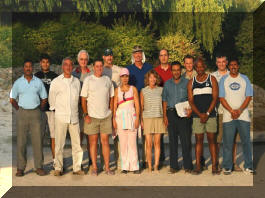 (click
to view photos)
(click
to view photos)
Archery in Dubai
By Rick Stonebraker
Oct 13-15, 2005
I had the privilege of teaching an archery instructors course in Dubai recently.
This came about back in April when a Texan working as an oil manager in Dubai
came to Houston on business. (See
WHODATHUNKIT)
During a day off, I instructed and he earned his Level One Instructor
Certification and came back the following Sunday to learn more. He was pretty
excited about his new found archery experience and went back to the
Dubai Archery Club expressing
enthusiasm to his fellow archers. That got the ball rolling with the club and
then through e-mail, the club asked if I was interested in traveling to Dubai to
instruct more potential instructors.
The Dubai Archery club has an excellent archery range on the grounds of the
Dubai Country Club where it is flat and lots of sand…it is in a desert. They
have introduced many people to the sport with their energy, enthusiasm and are a
positive influence in the development of archery in the U.A.E. (United Arab
Emirates). Some of the 14 students came from the local Dubai Archery Club and
the rest came from desert resorts in the area. These resorts offer archery but
more or less on the basis of the instructors showing them the equipment and
where the range is. That is about the extent of their program, so they were more
than excited to be instructed in the correct manner of teaching others. They
learned a whole lot more than they bargained for. They seemed to have a great
time and were filled with enthusiasm.
There was a definite language barrier but it all worked out. The nationalities
of the students included: South African, English, Scottish, French, Spanish,
Pakistan, Indian, Moroccan, Iranian and two Texans. The mid afternoon
temperatures averaged 108F with a peak of 116F. Summer temperatures can be a
blistering 126F.
An off day took me on a safari into the desert to an authentic Bedouin camp. We
were in a caravan of 20 four-wheel drive vehicles that traversed the dunes and
did some hair raising dips and curves. We stopped at a camel breeding area to
take photos and mingle with the Dromedaries before continuing on. We stopped
along the way to take photos of the sun as it set across the sea of sand.
We arrived at the Bedouin camp at dusk and road the camels around the camp
for awhile. Everyone sat on pillows and carpets under tents and dined on
traditional dishes and meats. Belly dancing was curtailed during the holy month
of Ramadan as well as eating or drinking from sunrise to sunset.
Restaurants are closed during daylight hours unless they can be totally shielded
from the viewing public. They can sell food to go but the food cannot be eaten
in public. Food courts in malls are closed during daylight hours.
Most of the drinking water in that part of the middle east comes from
desalination plants where salt is extracted from sea water becoming distilled
water and then minerals added back. Ground water in the form of artesian wells
crops up in many places in the desert region called Wadis, similar to an oasis.
We drove past the International Center
for Biosaline Agriculture that is trying to cope with the problems of saline
soils or irrigation with salty water. Its mission is to develop and promote the
use of sustainable agricultural systems that use saline water to grow crops. We
take good drinking water for granted.
I left Houston on Oct 7 to fly to Chicago to London, changed planes and
continued on to Dubai where it took me a little over 20 hours traveling time.
Dubai is nine time zones from Houston. I adapted quickly but going to bed at
10pm at night is 1pm in the afternoon Houston time. The trip home on Oct 17 took
23 hours as we had to disembark in Chicago, claim our luggage, go through
customs and check our bags back onto the same airplane we got off to continue to
Houston.
It was an enlightening trip, very diverse and an excellent experience!
Rick Stonebraker